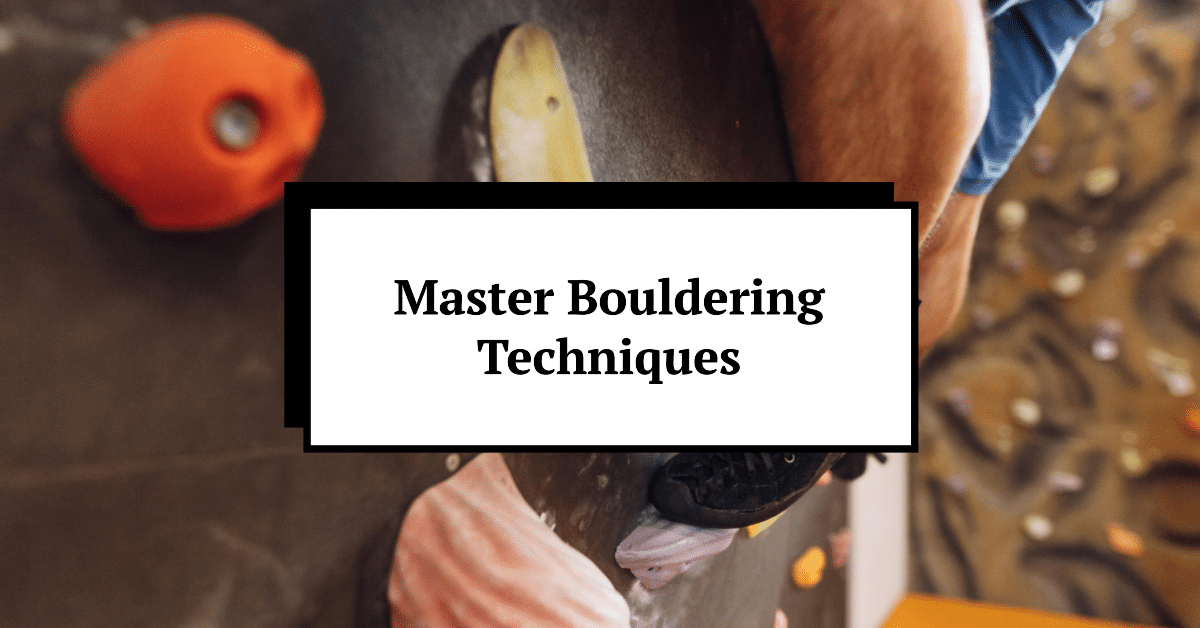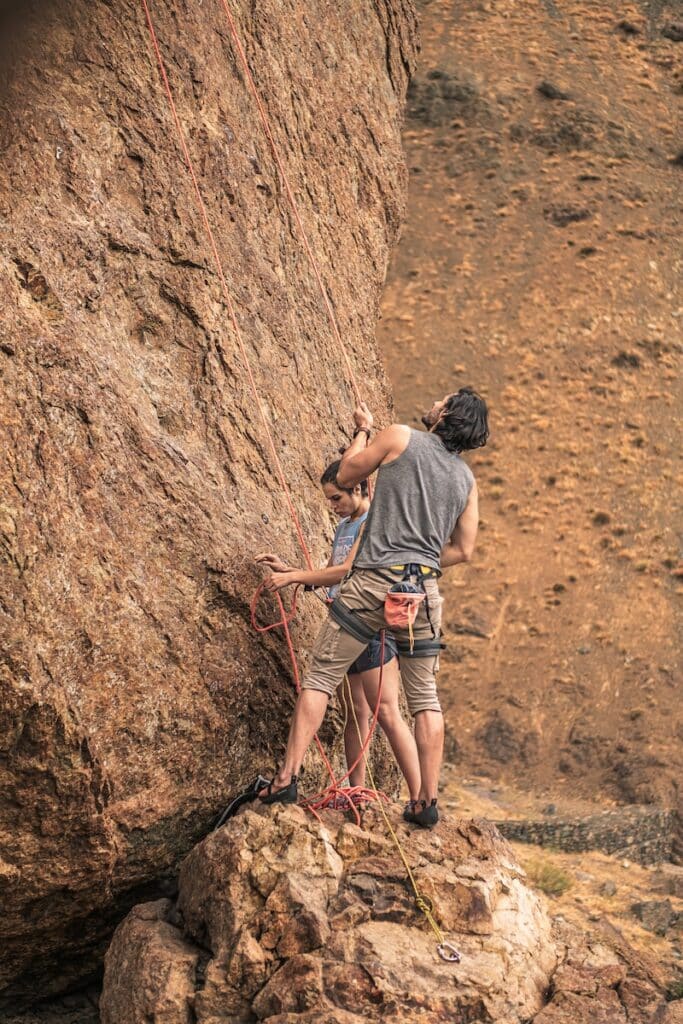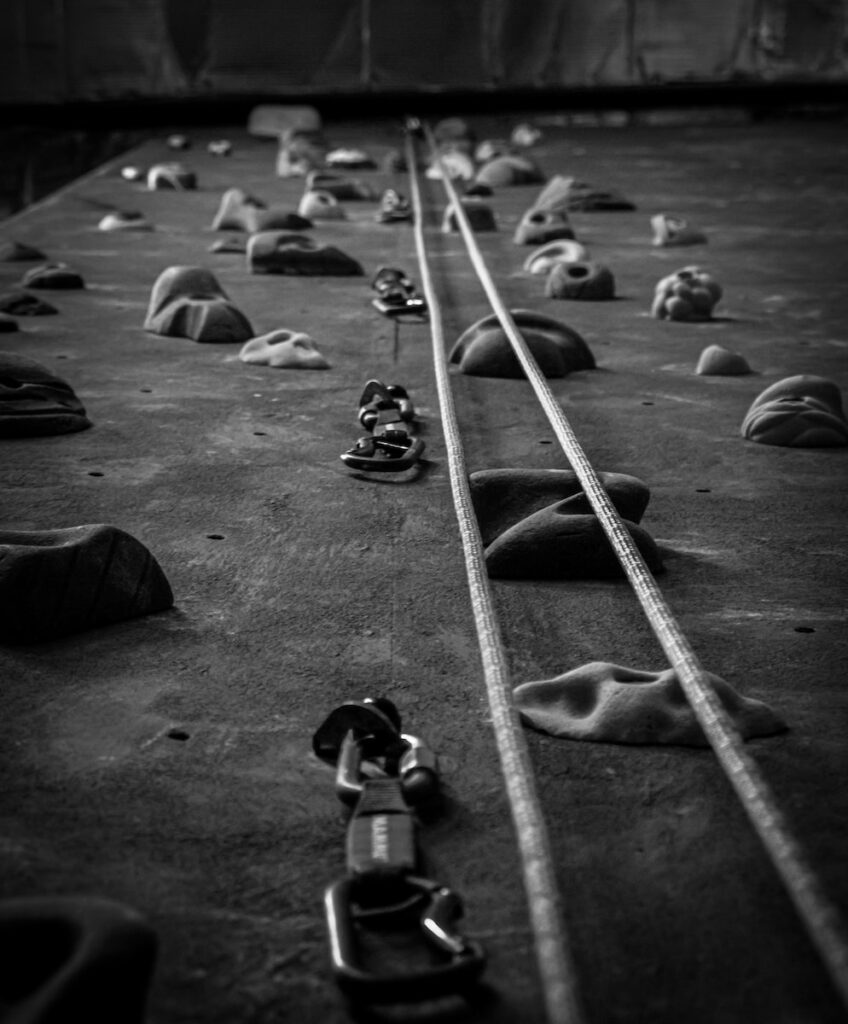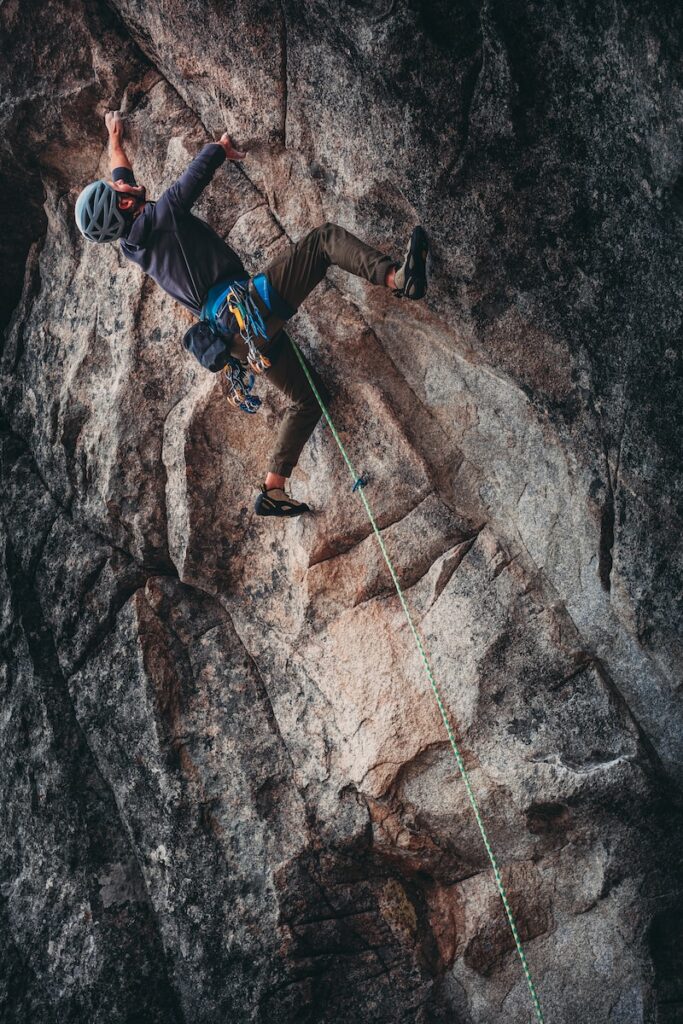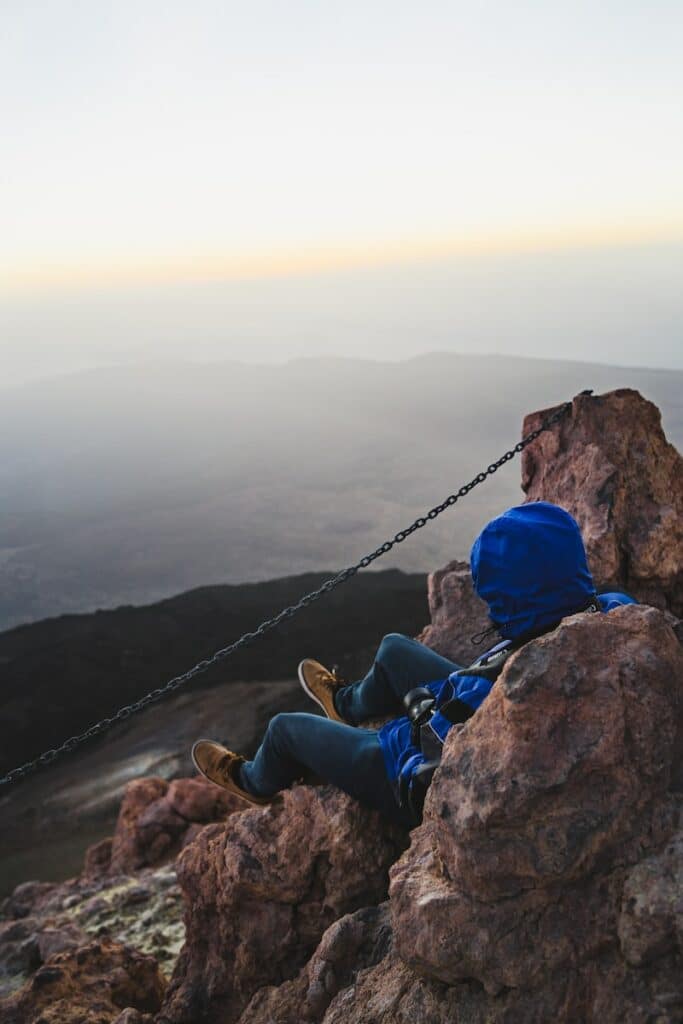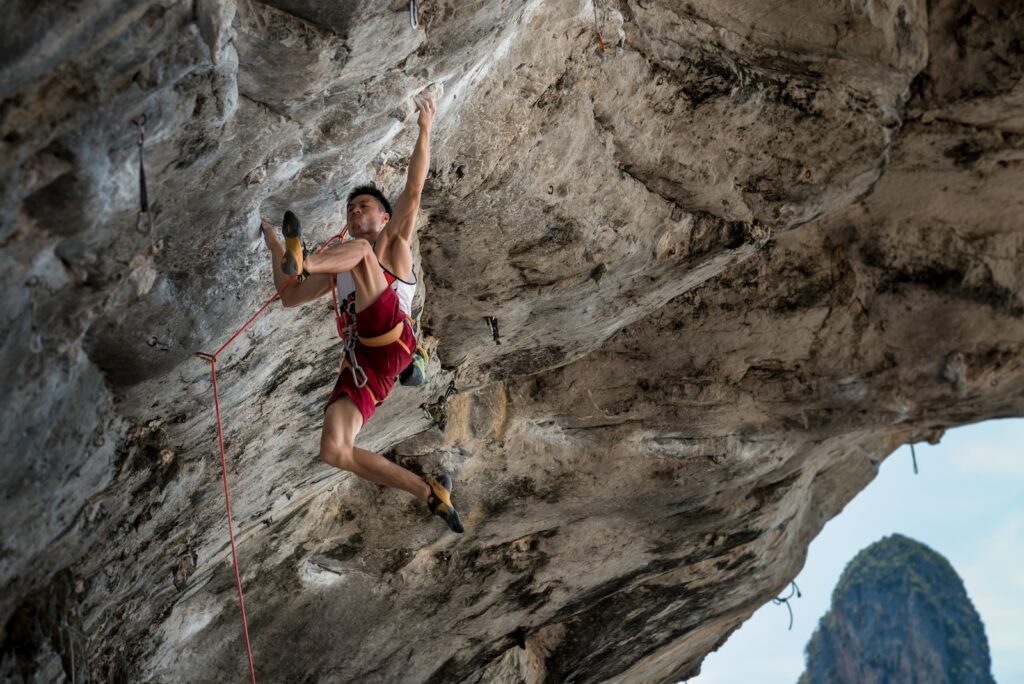
Rock climbing is a physically demanding activity that offers a challenging puzzle for enthusiasts. The act of ascending a wall demands a coordinated effort between the mind and body, resulting in enhanced self-awareness and confidence. Apart from the psychological benefits, rock climbing serves as an effective full-body workout that targets specific muscle groups and improves overall fitness levels. Additionally, it provides an opportunity to build new social connections and immerse oneself in the great outdoors. In this step-by-step guide, we will cover various and essential bouldering techniques to get you up and climbing in no time!
Table of Contents
ToggleThe Various Climbing Disciplines
Rock climbing comprises various disciplines, each demanding specific gear and training. While captivating images often portray climbers hanging from ropes hundreds of feet above the ground, this represents merely one facet of the sport. Numerous other climbing styles keep enthusiasts much closer to the earth’s surface. Rock climbing is a multifaceted world that can be daunting for beginners. However, top-rope climbing (top-roping) or bouldering techniques can serve as accessible and rewarding ways to start exploring this exciting activity. Both indoor climbing gyms and outdoor settings are great places to begin your journey.
Bouldering: An Accessible and Beginner-Friendly Activity
Embarking on bouldering techniques necessitates minimal specialized gear and technical know-how, making it an accessible choice for beginners. While some advanced climbs may reach considerable heights, most bouldering routes, often dubbed “problems,” only ascend to a height from which you can comfortably jump off. This beginner-friendly rock-climbing activity only requires basic gear like climbing shoes, a chalk bag, and a crash pad for safety, along with experienced spotters to guide landings. The absence of a rope, harness, or additional hardware adds to the simplicity and immediacy of the bouldering experience.
Top-Roping: Elevating the Climbing Experience
Engaging in top-rope climbing, also known as top-roping, elevates you to greater heights compared to bouldering and involves the use of a protective rope system. The climber secures themselves to one end of a rope threaded through an anchor at the route’s summit. As the climber progresses upward, a designated individual, referred to as the “belayer,” employs a belay device to manage slack on the opposite end of the rope. Maintaining tension in the rope, the belayer plays a crucial role in minimizing the potential fall distance if the climber loses footing. Learning the art of belaying is an essential skill, and many introductory climbing classes provide instruction on this fundamental aspect of top-rope climbing.
Advanced Climbing: Reaching New Heights
As you progress in your journey through Bouldering Techniques, you may explore more advanced climbing disciplines. Two of these disciplines are trad climbing and sport lead climbing.
Traditional (Trad) Climbing: A Test of Skill and Technique
Trad climbing involves carrying and positioning gear called “pro” into natural cracks and vulnerabilities of the rock to safeguard against falls. No pre-installed bolts exist on the rock surface. After climbing, you either retrieve the pro or have your partner remove the pieces. Trad climbing demands considerable skill and aligns with Leave No Trace principles as no equipment is left permanently embedded in the rock.
Sport Lead Climbing: Conquering the Vertical Challenge
This climbing style involves ascending by securing oneself to pre-drilled bolts on the climbing surface using quickdraws. This method ensures safety in areas lacking natural protection features. Quickdraws are pre-placed on walls in indoor sports climbing. It is riskier than top-roping due to the absence of a rope anchored at the top of the route.
Getting Started with Rock Climbing
Now that you have a grasp of the various climbing disciplines, it’s time to start practicing and honing your skills. Whether you choose bouldering or top-rope climbing, there are options for both indoor and outdoor settings.
Indoor Climbing: A Controlled Environment for Beginners
Indoor gyms are a great place to start your climbing journey, especially for beginners. These facilities offer routes of varying difficulty levels, allowing you to progress at your own pace. Indoor climbing gyms provide a controlled environment with protective floor mats for safe landings, color-coded plastic holds marking pre-set routes, pre-established top ropes, and a vibrant social atmosphere. Many gyms also host classes to refine or acquire new climbing skills. Indoor bouldering is particularly accessible, requiring minimal gear and offering a social atmosphere where climbers collaborate to solve boulder problems.
Outdoor Climbing: Venturing into the Wild
Venturing outdoors to climb on actual rock introduces an extra layer of excitement and requires a bit more experience. Unlike the controlled environment of indoor facilities with pre-set routes, ascending real rock necessitates an experienced climber or guide to construct the anchor for setting up a top rope. However, with the right knowledge and skills, outdoor climbing can be an incredibly rewarding experience. Organizations, guiding companies, gyms, and climbing groups are available online or near you that offer introductory classes and help overcome perceived barriers to entry.
Learning the Basics of Rock Climbing
To ensure a safe and enjoyable climbing experience, it’s important to learn the basics of rock climbing. Whether you choose to start indoors or outdoors, acquiring the necessary skills and knowledge will set you up for success.
Taking a Climbing Course: Learn from the Experts
If you are interested in top-rope climbing, it’s necessary to learn the basics from a skilled climber or a certified instructor. You can join a local climbing group or hire a qualified guide to assist you. In the United States, organizations such as the American Mountain Guides Association and the Professional Climbing Guides Institute provide certification for guides.
Essential Skills to Learn Along the Way
In a standard introduction to a top-rope climbing course, participants can expect a comprehensive examination of gear, fundamental knots, belay checks, climbing commands, belaying techniques, and basic movement skills. If the course takes place outdoors, instructors will additionally cover strategies for mitigating risks inherent in outdoor climbing, such as potential rockfall or exposure. Here are some essential skills you can expect to learn:
- Knots: Climbers typically employ a Figure-8 Follow Through knot to secure themselves to the end of the rope during climbing.
- Checking Belay: It’s important to conduct a thorough check of the system before starting the ascent to ensure proper setup.
- Learn the Lingo: Climbers and belayers use specific phrases to communicate, enhancing safety and efficiency.
- The Importance of Belay: Acquire the skills to configure a belay device, utilizing it to maintain tautness in the rope and safely lower the climber back to the ground.
- Basic Movements: Climbing is not just about upper body strength. Your instructor will teach you how to use your legs efficiently and the fundamentals of footwork, body positioning, and balance.
Gear Required for Rock Climbing
When you start climbing at a gym or with an instructor, they usually provide the necessary equipment. However, as you progress, it’s a good idea to invest in your own complete set of climbing gear. Here are some essential pieces of gear you may need:
- Climbing Helmet: Climbing helmets are designed to protect your head from falling rocks and debris.
- Climbing Harness: Your harness enables a secure connection to the rope.
- Belay Equipment: Possessing and proficiently using this equipment grants the belayer the capacity to skillfully manage the rope.
- Carabiners: A locking carabiner is a specialized type of carabiner that features a mechanism to secure the gate, preventing unintentional opening during use.
- Climbing Rope: The rope is undeniably a pivotal piece of gear essential for any rock-climbing endeavor.
- Climbing Shoes: When selecting rock climbing shoes, it’s crucial to prioritize a balance between a secure, snug fit and sufficient grip.
Transitioning to Outdoor Climbing
After building your strength and technique, and mastering the essential safety skills, it’s time to venture outdoors. Climbing outdoors, especially without a guide, depends entirely on your skills, equipment, and judgment. Given the inherent risks, your safety should be your top priority, especially during your initial outdoor experiences. If you’re uncertain about your group’s competence, opting for a guide can provide invaluable support.
When climbing with friends, who provide gear and expertise, it’s essential to acknowledge their efforts. While they may be enthusiastic about introducing you to outdoor climbing, being a cooperative team player is key. You can contribute by belaying fellow climbers, sharing the load of gear, and offering to cover group expenses like gas or food for the day. As you accumulate experience and savings, you can gradually invest in personal gear such as ropes and hardware to enhance your collective climbing resources.
Embracing the Ongoing Journey of Rock Climbing
Once you’ve mastered the basics, rock climbing opens up a world of possibilities for ongoing learning and progress. Some climbers prefer to tackle more complex movements, with indoor bouldering becoming a popular choice. Others are intrigued by the technical aspects of the sport, leading them to explore different disciplines like sport climbing, trad climbing, or aid climbing. The variety within rock climbing means that enthusiasts can customize their pursuits to match their preferences and goals for continuous development in the sport.
Perhaps your greatest desire is to engage in outdoor adventures and explore various climbing locations. To do so successfully, you must acquire skills such as interpreting guidebooks to find routes, mastering the setup and cleaning of top-rope anchors, and understanding outdoor climbing etiquette. While setting up top-rope anchors from the summit is possible in some cases, outdoor climbing usually requires honing lead climbing skills.
With a wide range of approaches available, both novice and experienced climbers can always discover new challenges in the complex vertical puzzle that is climbing. By embracing your curiosity, being open to learning, and cultivating enjoyment, climbing can become a lifelong passion to savor.
Safety First in Rock Climbing
When it comes to Bouldering Techniques, safety is paramount. That safety rests squarely on your shoulders. No online article or video can substitute for comprehensive instruction and hands-on experience. Ensure that you have honed proper techniques and familiarized yourself with safety protocols before embarking on any climbing endeavors.
conclusion
As we reach the summit of our bouldering techniques guide, we recognize the journey doesn’t end here. The skills and knowledge you’ve gained are more than just stepping stones; they are the foundation for a future rich with vertical challenges and personal triumphs. Remember, climbing is not solely about reaching the top but also about the growth experienced along the way. Stay safe, keep practicing, and let each climb refine your technique and broaden your horizons. Whether you find solace in the meditative repetition of indoor bouldering or seek the thrilling unpredictability of outdoor ascents, may your climbing adventures be as rewarding as the magnificent views they afford. Keep climbing, keep exploring, and most importantly, keep enjoying this vertical dance with gravity.

